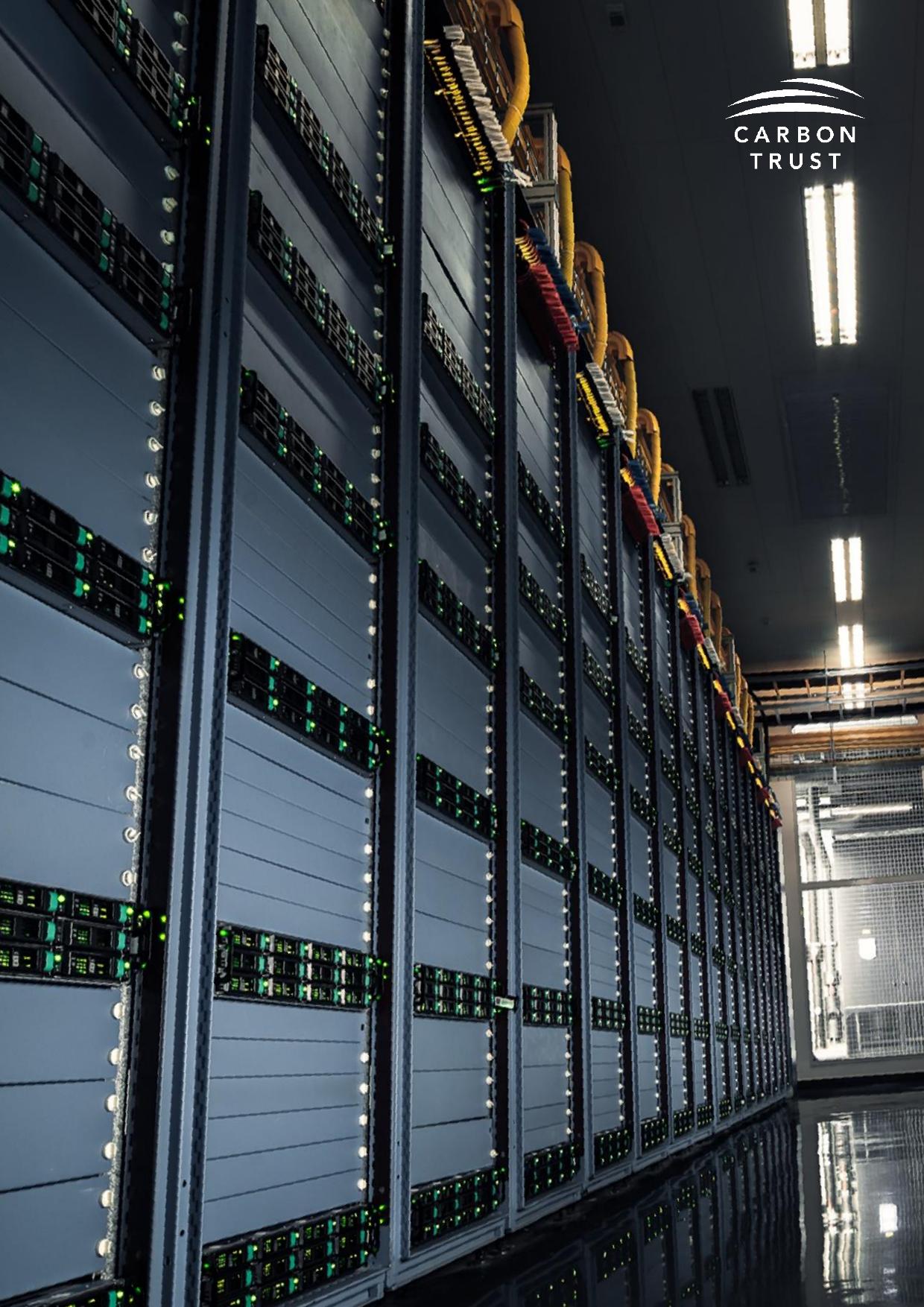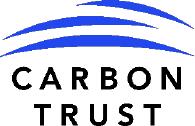REPORTAlibabaCloud’sCarbonBenefitsAstudyonenablingeffectsofAlibaba’sinternetdatacentres15August2022CarbonTrustAlibabaCloud’sCarbonBenefitsABOUTTHEREPORTAcknowledgmentsTheCarbonTrustauthoredthisreportbasedonanimpartialanalysisofprimaryandsecondarysources.ThisreportwascommissionedbyAlibabaCloud.Fortheavoidanceofdoubt,thisreportexpressesindependentviewsoftheauthors.AbouttheCarbonTrustWeareatrusted,expertguidetoNetZero,bringingpurposeled,vitalexpertisefromtheclimatechangefrontline.Wehavebeenpioneeringdecarbonisationformorethan20yearsforbusinesses,governmentsandorganisationsaroundtheworld.Wedrawontheexperienceofover300expertsinternationally,acceleratingprogressandprovidingsolutionstothisexistentialcrisis.Wehavesupportedover3,000organisationsin50countrieswiththeirclimateactionplanning,collaboratingwith150+partnersinsettingscience-basedtargets,andsupportingcitiesacross5continentsonthejourneytoNetZero.TheCarbonTrust’smissionistoacceleratethemovetoadecarbonisedfuture.CarbonTrustAlibabaCloud’sCarbonBenefitsAuthors:TinaTingyuHeSeniorAssociatetina.he@carbontrust.comRomanZiqingChenSeniorAnalystroman.chen@carbontrust.comRuihengJinAnalystruiheng.jin@carbontrust.comWithadditionaltechnicalsupportfromBeatrizFialhodaSilva,VeronikaThieme,andMattAnderson.1ContentsContents..............................................................................................................................1EXECUTIVESUMMARY......................................................................................................41.INTRODUCTION...............................................................................................................61.1.Datacentres’energyconsumptionisontheriseandfacessteepchallengesfordecarbonisation....................................................................................................61.2.Cloudcomputingdatacentrescanoffersignificantbenefitsincuttingdownenergyuseandconsequentlygreenhousegasemissions.....................................71.3.ThisstudyaimstoimprovetheunderstandingofthecarbonabatementAlibabaCloudcanenableforitscustomerscomparedtoon-premiseequivalents.81.4.Limitationsofstudy............................................................................................82.METHODOLOGY..............................................................................................................92.1.ThisstudyalignswiththeestablishedScope3+EmissionsReduction:ANewMethodologyforCorporateClimateActionsBeyondValueChainsandTheAvoidedEmissionsFrameworkwhencalculateAlibabaCloud’scarbonbenefits.92.2.AlifecycleapproachwasappliedtoestimateAlibabaCloud’sdatacentres’carbonfootprint,coveringupstream,usephase,anddownstreamemissions...113.FINDINGS.......................................................................................................................133.1.China-basedinternaldatacentresareestimatedtoemitasmuchas6.6timesmorethanAlibabaIDCs,allelsebeingequal.........................................................133.2.Largestcarbonsavingscomefromtheusephase,followedbythoseintheupstream;low-carbonelectricityprocurementisexpectedtofurtherincreaseAlibabaCloud’scarbonsavingpotential................................................................13Appendix1:ComparisonwithOtherScenarios..............................................................15Appendix2:FurtherNotesontheMethodology.............................................................17Modellingapproachtousephaseemissions.........................................................17Modellingapproachtoupstreamemissions...........................................................21Modellingapproachtodownstreamemissions......................................................22Appendix3:DataQuality..................................................................................................242TablesTable1:OverviewoftheAWSandMicrosoftstudies....................................................11Table2:AlibabaCloud'semissionboundarysummary.................................................12Table3:Serverutilisationassumptionsforthereferencescenarios............................19Table4:Datastorageequipmentassumptionsforthereferencescenarios................20Table5:PUEassumptionsforthereferencescenarios.................................................20FiguresFigure1:AlibabaIDCs'carbonbenefitscomparedtointernaldatacentres..................5Figure2:Datacentres'emissionstrajectories,2015to2030...........................................6Figure3:Cloudcomputing'scarbonbenefits...................................................................7Figure4:FrameworkforquantifyingAlibabaIDCs'enabledcarbonabatement..........10Figure5:AlibabaIDCs'carbonbenefitscomparedtointernaldatacentres................13Figure6:DriversofAlibabaIDCs'carbonbenefits........................................................14Figure7:AlibabaIDCs'carbonbenefitscomparedtoserviceproviderdatacentres..15Figure8:AlibabaIDCs'carbonbenefitscomparedtohyperscaledatacentres...........16Figure9:Overviewofmodellingapproach.....................................................................173AbbreviationsAWSAmazonWebServicesBAUBusiness-as-usualHDDHarddiskdriveICTInformationandcommunicationstechnologyIDCInternetdatacentreITUInternationalTelecommunicationUnionkWhkilowatt-hourPUEPowerusageeffectivenessSDDSolid-statedrive4EXECUTIVESUMMARYWiththerapiddigitisationofthemoderneconomy,thedatacentresectorisexpectedtogrowinthecomingyearstomeettheincreasingdemandfordataprocessingandstorage,andassuch,theassociatedgreenhousegasemissionswillalsoincrease.TheInternationalTelecommunicationUnion1forecaststhattheseemissionsmayreach141.5millionmetrictonnesby2030,upbynearly30%comparedtothe2020level.ThesectorundoubtedlyfacessteepchallengestoalignwiththeParisAgreementtrajectory.Meanwhile,emergingtechnologiessuchascloudcomputinghassignificantpotentialtoenableitscustomerstoavoidemissions,asitallowscomputingresourcestobeaggregatedandachievegreaterenergyefficiencythantraditional,on-premisedatacentresownedbyorganisationstosupportinternaloperations.PreviousstudiesonAmazonWebServices2andMicrosoftAzure3,forexample,haveattemptedtoquantifysuchcarbonbenefitsforusersswitchingfromon-premiseequivalents.AsAlibabadeployscloudcomputingtechnologiestopoweritscloudservicesinChinaandworldwide,thereisincreasinginteresttounderstandtheextenttowhichAlibabaCloudcanenableitscustomerstoavoidemissions.ThisstudyaimstoimprovetheunderstandingofthecarbonabatementAlibabaCloudenabledforitsChina-basedcustomerscomparedtocontinuingtousein-housedatainfrastructure.FollowingScope3+EmissionsReduction:ANewMethodologyforCorporateClimateActionsBeyondValueChainsdevelopedbyAlibabaGroupandCEC,andTheAvoidedEmissionsFrameworkdevelopedbytheCarbonTrust,wecomparedAlibabainternetdatacentres’upstream,usephase,anddownstreamemissionswiththoseofanon-premiseequivalentscenario,wheredataareprocessedandstoredinoff-cloudserversrunbyinternaldatacentres.TheresultsshowthatAlibabaCloud,whenrunningonAlibaba’sownedinternetdatacentres(IDC)inChina,canhelpavoid85.5%oftheemissionsforChina-basedusersswitchingfromon-premiseequivalents.Thelargestcarbonsavingscomefromimprovedpowerusageeffectiveness(PUE)andreducedpowerdrawofserversduringadatacentre’susephase.FurthereffortsshouldbedevotedtoinvestigatingAlibabaCloud’scarbonbenefitswhentheirleaseddatacentresareconsideredandataglobalscale.1ITU(2020).RecommendationITU-TL.1470:GreenhousegasemissionstrajectoriesfortheinformationandcommunicationtechnologysectorcompatiblewiththeUNFCCCParisAgreement.2451Research(2019).TheCarbonReductionOpportunityofMovingtoAmazonWebServices.3Microsoft(2020).Thecarbonbenefitsofcloudcomputing.5Figure1:AlibabaIDCs'carbonbenefitscomparedtointernaldatacentres61.INTRODUCTION1.1.Datacentres’energyconsumptionisontheriseandfacessteepchallengesfordecarbonisation.Withtheincreasinguseofdatainoureverconnectedanddigitisedeconomy,datacentresareexpandingsignificantly,andwithitcomestherapidgrowthinenergyconsumption.TheInternationalTelecommunicationUnion(ITU),thespecialisedagencyundertheUnitedNationscoordinatingglobalaffairsrelatedtotheinformationandcommunicationtechnology(ICT)sector,estimatedthatdatacentresin2020accountedforaround2%oftheelectricityconsumedand0.4%ofgreenhousegasemittedglobally4.Asthedatacentresectorisexpectedtocontinuegrowingintheyearstocome,itsgreenhousegasemissionscanalsogrowsignificantlyifdecarbonisationmeasuresdonottakeplace.By2030,thesector’sabsoluteemissionsareexpectedtoincreaseby10%inabusiness-as-usualscenario5.ThistrendposessignificantchallengestoaworldalreadyurgentlyinneedoffastanddeepemissionsreductiontostayontrackwithgoalssetoutbytheParisAgreement(seeFigure2).Figure2:Datacentres'emissionstrajectories,2015to203064ITU(2020).RecommendationITU-TL.1470:GreenhousegasemissionstrajectoriesfortheinformationandcommunicationtechnologysectorcompatiblewiththeUNFCCCParisAgreement.5Abusiness-as-usualscenarioherereferstothescenarioinwhichtheenergymixofgridelectricityremainsunchangedfromthecurrentlevel.Inthisscenario,theincreaseinemissionsresultfromincreasedelectricityconsumption,whichisaffectedbyacombinationoftrendssuchasconsolidation,virtualization,hardwaredevelopment,cloudificationandPowerUsageEffectiveness(PUE)development.6AnalysisfromITU(2020)04080120160200201520202025E2030EEmissions(MTCO2e)1.5degreescenario(embodiedemissions)1.5degreescenario(operation-relatedemissions)Business-as-usualscenario71.2.Cloudcomputingdatacentrescanoffersignificantbenefitsincuttingdownenergyuseandconsequentlygreenhousegasemissions.Toaddresstheclimatecrisis,reducingthesector’sowncarbonfootprintisonlyonepartoftheequationinachievingnetzero–innovativesolutionsareurgentlyneededtoenabletherapidreductionsinemissionswhilemeetingtheworld’sneeds7.Asdatacentresplayanevermoreimportantroleinoureconomy,companiesthatcansupplylow-carbondataprocessingandstorageservicesholdsignificantpotentialinenablingtheircustomerstoavoidemissions,thusreducingtheoverallcarbonfootprint.Cloudcomputinghasemergedinrecentyearsasanewcomputingparadigmthatcansignificantlyincreasedatacentres’energyefficiencycomparedtoconventional,on-premisedatacentres.Throughaggregatingcomputingresources,large-scaledatacentrescoupledwithcloudtechnologiescanbettermanagetheoverallpowerconsumption.AspreviousstudiessuchasAccenture(2011)8explained(seeFigure3),cloudcomputingachievesthischieflyinthreeways:dynamicallyprovisioningcomputingcapacity,multi-tenancy,andimprovedserverutilisation.1.Dynamicprovisioning:On-premisedatacentresarecommonlyover-provisionedwithactiveITequipmenttoensurepeakbusinessdemandsaremet.Cloudcomputingenablescomputingresourcestobedynamicallyprovisioned,whichoptimisesthematchingofservercapacitywithactualdemand.2.Multi-tenancy:Asthecloudservesmultipleusersatthesametime,demandpatternsbecomeflattened,thusrequiringlessadditionalcapacitytomeettheoverallpeakdemand,whichinturnreducestheoverheadforindividualusers.3.Serverutilisation:Cloudcomputingenablesserverstorunathighutilisationlevels,meaningthatthesamedemandcanbedonebyfewerserverswhencomparedtoon-premiseequivalents.Eventhoughpoweruseperservermayincreaseaccordingtotheincreasedlevelofutilisation,itisstillmoreenergyefficienttorunfewerhighlyutilisedthanmoreserversatlowutilisation,becauseserversdonotdrawpowerperfectlyproportionaltotheirutilisationandstillrequirepoweratlowutilisationorevenduringidleperiods.Figure3:Cloudcomputing'scarbonbenefits97Stephens&Thieme(2020).TheAvoidedEmissionsFramework.MissionInnovation.8Accenture(2010).CloudComputingandSustainability:TheEnvironmentalBenefitsofMovingtotheCloud.9AdaptedfromAccenture(2010).8Todate,selectedcloudcomputingserviceprovidershavepublishedstudiesonhowtheirsolutionsarecreatingcarbonbenefitstotheircustomers,thatis,enablingthemtocreatenetenabledcarbonabatementbyswitchingfromthelessefficient,on-premisealternativestotheirsolutions.Forexample,a2019studycommissionedbyAmazonWebServices(AWS)10foundthatmovingtoAWSwouldresultina72%reductionincarbonemissionsfromtheirenterprisebaseline,whereasa2020Microsoftstudy11foundthatAzureComputeis52to79%moreenergyefficientthanitson-premiseequivalent.1.3.ThisstudyaimstoimprovetheunderstandingofthecarbonabatementAlibabaCloudcanenableforitscustomerscomparedtoon-premiseequivalents.In2021,Alibabalauncheditscarbonneutralityactionreport,committingtopoweringAlibabaCloudwith100%cleanenergybynolaterthan2030.Byscalingitscloud-basedsolutionstoawidercustomerbase–especiallythosewhohavereliedontraditional,on-premisedatafacilities–AlibabaCloudholdssignificantpotentialtoreduceenergyuseandcarbonfootprintforitscustomers.ItisinthiscontextthattheCarbonTrustwascommissionedtoconductthisstudyandestablishacrediblebasisforquantifyingAlibabaCloud’scarbonsavingpotential.ThisstudyassessedtheenergysavedandenablingeffectsforaChina-baseduserswitchingtoAlibabaCloudfromitson-premiseequivalents.1.4.LimitationsofstudyTherearetwomajorlimitationsofthisstudy.First,thoughAlibabaCloudisaglobalproductthatrunsonserversinownedandleaseddatacentresworldwide,thisstudyonlyconsideredtheIDCsownedbyAlibabainChina,asdataonleaseddatacentres’poweruseeffectivenesswerenoteasilyavailable.AsAlibabahasdirectcontrolovertheseIDCs,theyarelikelytobemoreenergyefficientthantheleaseddatacentresduetodesignchoicesmadeattheearlystage.Thus,thefindingsmaynotberepresentativeofAlibabaCloud’scarbonbenefitsataglobalscale.Second,asAlibabaClouddeploysamixofownedandleaseddatacentresinChinatoserviceChina-basedusers,findingsbasedontheownedIDCsarelikelytoalsooverestimatethecarbonbenefitsforChina-basedusers.Fortheavoidanceofdoubt,thecarbonbenefitsorenablingeffectsdescribedinthisreportreferspecificallytoenabledcarbonabatementforaChina-baseduserswitchingtoAlibabaCloudpoweredbyitsownedIDCs.FurtherstudieswillconsiderAlibabaCloudproductataglobalscalewhereregion-specificparameterswillbeadoptedincalculation,andenablementfactorswillbegeneratedtorepresentindividualregionswhenmeasuringthecarbonbenefitsofAlibabaCloudcomparedtoon-premisesdatacentres.10451Research(2019).TheCarbonReductionOpportunityofMovingtoAmazonWebServices.11Microsoft(2020).Thecarbonbenefitsofcloudcomputing.92.METHODOLOGY2.1.ThisstudyalignswiththeScope3+EmissionsReduction:ANewMethodologyforCorporateClimateActionsBeyondValueChainsandTheAvoidedEmissionsFrameworkwhencalculateAlibabaCloud’scarbonbenefits.TodatethereisnotyetaninternationallyuniformguidanceoncalculatingtheenvironmentalbenefitsofICTsolutions,thougheffortsbytheEuropeanUnionareunderwaytoestablishrelevantscience-basedmethods12.Scope3+EmissionsReduction:ANewMethodologyforCorporateClimateActionsBeyondValueChains13publishedbyAlibabaGroupandChinaEnvironmentalUnitedCertificationCentre(CECinshort),togetherwithTheAvoidedEmissionsFramework(2020)14developedbytheCarbonTrusthavedevelopedbroadframeworkandmethodologiesthathelpcorporatestomeasurecarbonbenefits.Followingmethodologiessuggestedinthesetworeports,thisstudydefinesAlibabaCloud’scarbonbenefits,otherwisereferredtoas’carbonsavings’or’enabledcarbonabatement’inthisreport,as“reductionsinemissionscausedindirectlybyaproduct…whereaproductprovidesthesameorsimilarfunctionasexistingproductsinthemarketplace,butwithsignificantlylessGHGemissions”15.Thebasisofthemethodologyisthatthecarbonbenefits(i.e.,netenabledcarbonabatement)arecalculatedbycomparingtheGHGemissionsfromabusiness-as-usual(BAU)baselinescenariowiththosefromasolution-enabledscenariotodemonstratethebenefitofthesolutiontoreduceoverallsystemlevelGHGemissions.𝑁𝑒𝑡𝑎𝑣𝑜𝑖𝑑𝑒𝑑𝑒𝑚𝑖𝑠𝑠𝑖𝑜𝑛𝑠=𝐵𝐴𝑈𝑏𝑎𝑠𝑒𝑙𝑖𝑛𝑒𝑒𝑚𝑖𝑠𝑠𝑖𝑜𝑛𝑠−𝑒𝑚𝑖𝑠𝑠𝑖𝑜𝑛𝑠𝑜𝑓𝑡ℎ𝑒𝑠𝑜𝑙𝑢𝑡𝑖𝑜𝑛𝑒𝑛𝑎𝑏𝑙𝑒𝑑𝑠𝑐𝑒𝑛𝑎𝑟𝑖𝑜Itshouldbenotedthatasonemakestheswitchfromon-premisedatacentrestoAlibabaCloud,newemissions,otherwiseknownas“reboundeffects”,mayoccur.Forexample,becauseoftechnologicaladvancementandmassiveefficiencygains,thecostofswitchingtocloudcomputingdatacentresisdrivendown,whichmayattractcompaniestobringmoredataprocessingtothecloudandconsequentlyresultinsignificantspikesintheservicedemandandpowerconsumption.Thisstudydidnotaddressthesereboundeffectsduetotheuncertaintyinquantifyingthem.12Globale-SustainabilityInitiative(2022).TheEuropeanGreenDigitalCoalitiongetsaboostbytopAssociations:Layingthefoundationalworkforthedigitalandgreentwintransitions.13AlibabaGroupandCEC2022.Scope3+EmissionsReduction:ANewMethodologyforCorporateClimateActionsBeyondValueChains14Stephens&Thieme(2020).TheAvoidedEmissionsFramework.MissionInnovation.15GHGProtocolProductStandard–seechapter11,sections11.2and11.3.2.10Figure4:FrameworkforquantifyingAlibabaIDCs'enabledcarbonabatementAssuggestedbyScope3+EmissionsReduction:ANewMethodologyforCorporateClimateActionsBeyondValueChains,abaselineorBAUscenariodeterminesthecarbonemissionslevelsintheabsenceofasolution/intervention,andthereisoftenmorethanonealternativesolution/interventionunderaBAUscenario.Whenestablishingthebaselineofcloudcomputing,threereferencescenarios,namelyinternaldatacentre,serviceproviderandhyperscale,definedintheShehabietal(2016)16wereusedtorepresentdifferentspacetypesofon-premisedatacentres.Specifically,thisstudyadopts“themostwidelyusedscenarioapproach”17todeterminethescenariothatbestreflectthemarketsituation.Asthe2020marketpenetrationofcloudcomputinginChinais7.5%18,internaldatacentres,whicharetraditionalfacilitiesownedbybusinessandinstitutionstosupporttheirinternaladministrativeandgeneraloperations,weredeemedasthemajortargettobereplacedbycloudcomputingservicesandthereforeconsideredasthebaselinescenarioinemissionabatementmeasurement.WealsomeasuredthecarbonbenefitsofAlibabaCloudwhencomparedtotheaverageserviceproviderandhyperscaledatacentrescenarios.ResultsofthesecomparisonsarepresentedinAppendix1,asthereisnocredibledataindicatingthelevelofrenewableelectricityuseinthesescenarios,whichrendertheresultslessrobust.16Shehabietal(2016).UnitedStatesDataCenterEnergyUseReport.ErnestOrlandoLawrenceBerkeleyNationalLaboratory.17AlibabaGroup&CEC(2022).Scope3+EmissionsReduction:ANewMethodologyforCorporateClimateActionsBeyondValueChains.TheAvoidedEmissionsFramework(2020)18Marketpenetrationwascalculatedbycomparingthe2020marketscaleofcloudcomputingandtotalITexpenditureinChina.Dataretrievedfrom2022ChinaCloudComputingBlueBookdevelopedbyCCIAandTheITExpenditurereleasedbyGartnerin2020.112.2.AlifecycleapproachwasappliedtoestimateAlibabaCloud’sdatacentres’carbonfootprint,coveringupstream,usephase,anddownstreamemissions.BasedonScope3+EmissionsReduction:ANewMethodologyforCorporateClimateActionsBeyondValueChains,andTheAvoidedEmissionsFramework(2020),Emissionsreductionfromasolution/interventionistheoverallchangeinemissionsacrosseveryphaseofaproductorservice’slifecycleusingtheLCAapproach.Previously,datacentreserviceproviderssuchasAWSandMicrosofthavepublishedstudiesonthecarbonbenefitsenabledbytheirrespectiveproducts(seeTable1).Generally,aproduct’scradle-to-gravecarbonfootprintcoversthefollowinglifecyclestages:rawmaterialproductionanddistribution;productmanufacturing;distributionandretail;theusephase;andlastly,disposalandrecycling.19Atthesectorallevel,ITU’sreportonICTsectoremissionstrajectorieslargelycorrespondstothelifecycleboundarydefinition,includingemissionsofthedatacentresupplychain,manufacturers,operator’soverhead,andelectricityconsumption.20Table1:OverviewoftheAWSandMicrosoftstudiesPrioritisingthemostmateriallifecyclestagesandconsideringdataavailability,thisstudyincludedthefollowingemissionsassociatedwithdatacentres.1.Upstreamemissions:TheemissionsassociatedwiththeITequipment(includinginactiveservers)anddatacentreinfrastructure,suchasfrommaterials,manufacturing,construction,and/ortransportationprocesses,beforethedatacentreisinoperation.2.Usephaseemissions:TheemissionsfromITequipmentduringadatacentre’susephase,includingthatofserversandstoragedevices,aswellaspowerconsumedtomaintaintheoperationsofthedatacentreinfrastructure(e.g.forpurposesofcooling,lighting,controls).19BritishStandardsInstitution(2011).PubliclyAvailableStandard2050:Specificationfortheassessmentofthelifecyclegreenhousegasemissionsofgoodsandservices.20ITU(2020).RecommendationITU-TL.1470:GreenhousegasemissionstrajectoriesfortheinformationandcommunicationtechnologysectorcompatiblewiththeUNFCCCParisAgreement.123.Downstreamemissions:TheemissionsassociatedwiththeITequipment(includinginactiveservers)fromdisposalandrecyclingprocessesattheend-of-lifestage.Table2providesanillustrativesummaryoftheemissionsincludedinthisstudy’sboundarywhenassessingAlibabaCloud’scarbonbenefits.DetailedapproachesandassumptionsusedtomodeltheseemissionsareprovidedinAppendix1:.Table2:AlibabaCloud'semissionboundarysummary21RawmaterialproductionanddistributionProductmanufacturingUpstreamtransportationUsephaseDisposalandrecyclingITequipmentServersNoYesYesYesYesInactiveservers22NoYesYesNoYesDatastoragedrivesNoNoNoYesNoDatacentreinfrastructureYesYesYesYesNo21OtherITequipmenttypicallydeployedinadatacentre,suchasthenetworkingdevice,isdeemedimmaterialintermsoftheirenergyconsumptioncomparedtothatofserversanddatastorageequipment.Additionally,relevantnetworkenergyusedataislimitedtoestablishreferencescenarios.Thusthenetworkingequipmentwasnotincludedwithintheboundaryofthisstudy.22Inactiveservers(alsoreferredtoascomatoseor“zombie”servers)representobsoleteorunusedserversthatconsumeelectricitybutprovidenousefulinformationservices.133.FINDINGS3.1.China-basedinternaldatacentresareestimatedtoemitasmuchas6.9timesmorethanAlibabaIDCs,allelsebeingequal.Allthingsequal,China-basedinternaldatacentres’emissionsareestimatedtobe687.9%ofthoseofAlibaba’sownedIDCs(Figure5).ThismeanstherecanbesignificantcarbonbenefitsforChina-basedbusinessesandinstitutionstoswitchfromtheirexistinginternaldatainfrastructuretoAlibabaCloud.Figure5:AlibabaIDCs'carbonbenefitscomparedtointernaldatacentres3.2.Largestcarbonsavingscomefromtheusephase,followedbythoseintheupstream;low-carbonelectricityprocurementisexpectedtofurtherincreaseAlibabaCloud’scarbonsavingpotential.TheswitchtoAlibabaCloudpoweredbyAlibaba’sownedIDCscanenableaChina-basedusertoavoid85.5%oftheemissionsassociatedwithitscurrentuseofon-premisedatacentres(seeFigure6).Specifically,reducedserverpoweruse,whichisdrivenbycloudcomputingasoutlinedinFigure3isthelargestdriverforcarbonsavings,accountingfor39.8%oftotalemissionsavoided.Thesecondlargestsourceofenabledcarbonabatement(29.0%)comesfromimprovedPUEduringtheusephase.Thisisfollowedbyreducedupstreamemissionsassociatedwiththeservers,whichaccountsfor10.2%,andreducedinactive-serverembodiedemissions(5.2%).100.00%687.90%AlibabaIDCInternaldatacentre14Finally,asAlibabaIDCspartlyprocureelectricityfromlow-carbonsources23,thiscontributesafurther0.9%ofcarbonsavingscomparedtointernaldatacentres24.ThisratioisexpectedtogrowinthecomingyearsasAlibabascalesitscleanenergypurchase.Figure6:DriversofAlibabaIDCs'carbonbenefits23In2020,Alibabapurchasedrenewableelectricitycertificatesandsourcedelectricityfromnaturalgasplants.Thesehavebeencollectivelyreferredtoaslow-carbonelectricityprocurement.24GiventhestateofrenewableelectricitymarketinChina,thisstudyassumedthattheaverageinternaldatacentredidnotprocurerenewableelectricityinthebaselineyear.15Appendix1:ComparisonwithOtherScenariosFollowingthesameapproachasShehabietal(2016),thisstudyalsoinvestigatedAlibabaCloud’scarbonbenefitsagainstthefollowingreferencescenarios:1.Serviceproviderdatacentrescenario:Facilitiesthatprovidedataprocessingand/orstorageasacoreserviceofbusinesses,suchascommunicationandsocialmediacompanies.Thesedatacentresareoftenconfiguredformorespecialisedandpredictableoperations.2.Hyperscaledatacentrescenario:Largewarehouse-sizedatacentresthathaveemergedwiththegrowthincloudplatforms,mobiledevices,socialmedia,andbigdata.Foracustomerswitchingfromanaverageserviceproviderdatacentre,AlibabaCloudcanhelpachieveupto75.9%ofcarbonsavings,outofwhich36.3%arefromtheserverusephase,whileinfrastructureusephaseaccountsfor26.9%,followedbyserverupstreamembodiedemissions(9.3%)SeeFigure7foradetailedbreakdown.Similarlyforacustomerswitchingfromanaveragehyperscaledatacentre,AlibabaCloudcanhelpavoidupto60.0%oftheemissions,outofwhich33.1%arefromtheserverusephase,whileinfrastructureusephaseaccountsfor16.8%,followedbyserverupstreamemissionsat8.5%.SeeFigure8foradetailedbreakdown.Itshouldbenotedthoughthatthesecomparisonsdonotconsiderrenewableelectricityusage,whichmaysignificantlyskewtheseresultsgiventheincreasingambitionlevelsofserviceprovidersandhyperscaledatacentrestopowertheirserviceswithrenewables.Figure7:AlibabaIDCs'carbonbenefitscomparedtoserviceproviderdatacentres16Figure8:AlibabaIDCs'carbonbenefitscomparedtohyperscaledatacentres17Appendix2:FurtherNotesontheMethodologyFigure9summarisestheoverallmodellingapproachandthekeyparametersusedtocalculateemissionsfromthemainsourcesassociatedwithdatacentreswithinthisstudy’sboundary.Shehabietal(2016)wasreferencedextensivelyforthisstudy,includingthemodellingapproachforserver,storage,anddatacentreinfrastructure-relatedusephaseemissionsandrelevantkeyassumptions.Figure9:OverviewofmodellingapproachWhenmodellingAlibabaIDCs’emissions,thisstudyreliedonproduct-anddatacentre-leveldatatoensurethattheapproachwouldremainconsistentbetweenAlibabaCloudandthereferencescenariossothatresultsarecomparable.EmissionsassociatedwithAlibabaIDCsunderthisapproacharenottobemistakenasactualcarbonfootprintingresults,whichshouldideallybecalculatedbyusingactualenergyusedata.TheCarbonTrustdidnotverifynorassuretheaccuracyoftheproprietarydataprovidedbyAlibabaCloud.ModellingapproachtousephaseemissionsThreekeysourcesofenergyconsumptionduringadatacentre’susephasewereconsidered:powerconsumptionofservers,datastoragedrives,andtheinfrastructureneededtomaintainadatacentre’soperation(e.g.cooling,lighting,controls).Emissionsfrompowerconsumptionofserversarecalculatedusingthefollowingformula:𝐸𝑚𝑖𝑠𝑠𝑖𝑜𝑛𝑠𝑒𝑟𝑣𝑒𝑟𝑢𝑠𝑒=(𝑁𝑠𝑒𝑟𝑣𝑒𝑟×𝐸𝑠𝑒𝑟𝑣𝑒𝑟𝑎𝑣𝑔)×𝐸𝐹𝑒𝑙𝑒𝑐𝑡Where𝐸𝑚𝑖𝑠𝑠𝑖𝑜𝑛𝑠𝑒𝑟𝑣𝑒𝑟𝑢𝑠𝑒=emissionsofserverpowerconsumptionduringusephase𝑁𝑠𝑒𝑟𝑣𝑒𝑟=numberofservers𝐸𝑠𝑒𝑟𝑣𝑒𝑟𝑎𝑣𝑔=averagepowerconsumptionperserver𝐸𝐹𝑒𝑙𝑒𝑐𝑡=emissionfactorforelectricity(1)18Assumingtheserverspecificationsacrossdifferentscenariosdonotdifferinamaterialway,thenumberofserversmeetingthesamedatademandwouldstillvary,asserversunderdifferentscenariosareutilisedatdifferentrates.Asserversdrawpowerduringidleperiodsandhencedonothaveperfectpower-proportionality,i.e.,usingapercentageofmaximumpowerwhenrunningatthesamepercentageofutilisation,lowserverutilisationadverselyaffectsadatacentre’spowerconsumption.Conversely,whenserverutilisationisimproved,suchasbywayofserverconsolidation,thenumberofserversneededtomeetthesamedemandwillreduce,whichwillinturnimproveenergyefficiency.Theserver’spowerdrawmayvaryacrossbrandsandmodels,thoughwecouldnotmeaningfullydifferentiateserverpowerperformanceacrossdifferentscenariosduetothelackofrelevantdata.Thus,weusedtheaverageperformancefiguresbasedonpubliclyavailabledataof89servermodelsfrom2019to202125.Tocalculatetheaveragepowerconsumptionperserver,thefollowingformulaewerefollowed26:𝑚=𝑃𝑠𝑒𝑟𝑣𝑒𝑟𝑚𝑎𝑥×(1−𝐷𝑅)Wherem=slopeofutilisationveruspowerline𝑃𝑠𝑒𝑟𝑣𝑒𝑟𝑚𝑎𝑥=maximumserverwattageDR=dynamicrangeofserver(fractionofmaxpowerusedatidle)𝑃𝑠𝑒𝑟𝑣𝑒𝑟𝑎𝑣𝑔=𝑃𝑠𝑒𝑟𝑣𝑒𝑟𝑚𝑎𝑥−𝑚×(1−𝑢𝑠𝑒𝑟𝑣𝑒𝑟𝑎𝑣𝑔)Where𝑃𝑠𝑒𝑟𝑣𝑒𝑟𝑎𝑣𝑔=averageserverwattage𝑃𝑠𝑒𝑟𝑣𝑒𝑟𝑚𝑎𝑥=maximumserverwattagem=slopeofutilisationveruspowerline𝑢𝑠𝑒𝑟𝑣𝑒𝑟𝑎𝑣𝑔=averageserverutilisation𝐸𝑠𝑒𝑟𝑣𝑒𝑟𝑎𝑣𝑔=𝑃𝑠𝑒𝑟𝑣𝑒𝑟𝑎𝑣𝑔×𝐻Where𝐸𝑠𝑒𝑟𝑣𝑒𝑟𝑎𝑣𝑔=averagepowerconsumptionperserver𝑃𝑠𝑒𝑟𝑣𝑒𝑟𝑎𝑣𝑔=averageserverwattageH=totalrunninghoursoftheserverSeparately,tocalculatethenumberofserversthatcouldbeconsolidatedinthereferencescenarios,thefollowingformulaewerefollowed:𝑁𝑠𝑒𝑟𝑣𝑒𝑟𝑐𝑜𝑛=𝑢𝑠𝑒𝑟𝑣𝑒𝑟𝑝𝑜𝑠𝑡−𝑢𝑠𝑒𝑟𝑣𝑒𝑟𝑜𝑣𝑒𝑟ℎ𝑒𝑎𝑑𝑢𝑠𝑒𝑟𝑣𝑒𝑟𝑝𝑟𝑒−1𝑟𝑠𝑒𝑟𝑣𝑒𝑟𝑝𝑟𝑒25StandardPerformanceEvaluationCorporation.SPECpower_ssj2008Results.Accessedon29September2021fromhttps://www.spec.org/power_ssj2008/results/.26AsacknowledgedinShehabietal(2016),intheabsenceofdataonutilisationratesforservers,thisapproachassumesalinearrelationshipbetweenserverutilisationandpowerconsumption,whiletheactualrelationshipisgenerallynon-linear,resultinginalossofaccuracyinmodellingenergyuseatanaverageutilisationlevel.(2)(3)(4)(5)19Where𝑁𝑠𝑒𝑟𝑣𝑒𝑟𝑐𝑜𝑛=numberofserversthatcanbeconsolidatedintoone𝑢𝑠𝑒𝑟𝑣𝑒𝑟𝑝𝑜𝑠𝑡=post-consolidationserverutilisation𝑢𝑠𝑒𝑟𝑣𝑒𝑟𝑜𝑣𝑒𝑟ℎ𝑒𝑎𝑑=consolidationutilisationoverhead𝑢𝑠𝑒𝑟𝑣𝑒𝑟𝑝𝑟𝑒=pre-consolidationserverutilisation𝑟𝑠𝑒𝑟𝑣𝑒𝑟𝑝𝑟𝑒=fractionofpre-conslidationserversthatarenon-inactive𝑁𝑠𝑒𝑟𝑣𝑒𝑟𝑖=𝑁𝑠𝑒𝑟𝑣𝑒𝑟𝑐𝑜𝑛×𝑁𝑠𝑒𝑟𝑣𝑒𝑟𝐴𝑙𝑖Where𝑁𝑠𝑒𝑟𝑣𝑒𝑟𝑖=numberofserversinreferencescenarioi𝑁𝑠𝑒𝑟𝑣𝑒𝑟𝑐𝑜𝑛=numberofserversthatcanbeconsolidatedintoone𝑁𝑠𝑒𝑟𝑣𝑒𝑟𝐴𝑙𝑖=numberofAlibabaIDCs’serversAlibabaIDCs’targetserverutilisationwas98%,whichwasusedasthepost-consolidationserverutilisationratewhencomparedwiththereferencescenarios.Differentserverutilisationratesandnon-inactiveratesofper-consolidationserverswereassumedforthereferencescenarios(seeTable3),anda5%ofconsolidationutilisationoverheadwasassumedacrossscenariostoaccountforapplicationsthatmustberunontheservertobalancemultipleworkloads.Table3:Serverutilisationassumptionsforthereferencescenarios27ScenarioAverageserverutilisationNon-inactiverateofpre-consolidationserversInternaldatacentre15%70%Serviceproviderdatacentre25%80%Hyperscaledatacentre50%90%Emissionsfrompowerconsumptionofdatastorageequipmentarecalculatedusingthefollowingformula:𝐸𝑚𝑖𝑠𝑠𝑖𝑜𝑛𝑠𝑡𝑜𝑟𝑎𝑔𝑒=(𝑁𝑠𝑡𝑜𝑟𝑎𝑔𝑒×𝑃𝑠𝑡𝑜𝑟𝑎𝑔𝑒𝑎𝑣𝑔)×𝐸𝐹𝑒𝑙𝑒𝑐𝑡Where𝐸𝑚𝑖𝑠𝑠𝑖𝑜𝑛𝑠𝑡𝑜𝑟𝑎𝑔𝑒=emissionsfrompowerconsumptionofdatastorageequipment𝑁𝑠𝑡𝑜𝑟𝑎𝑔𝑒=numberofdatastoragedrivesinstalled𝑃𝑠𝑡𝑜𝑟𝑎𝑔𝑒𝑎𝑣𝑔=averagepowerconsumptionperdrive𝐸𝐹𝑒𝑙𝑒𝑐𝑡=emissionfactorforelectricityThedatastorageequipmentisdisaggregatedbytypetoreflectthedifferenceinstorageequipmentuseacrossscenarios.Thetwomostcommontypes,harddiskdrive(HDD)andsolid-statedrive(SSD),are27Shehabietal(2016).UnitedStatesDataCenterEnergyUseReport.ErnestOrlandoLawrenceBerkeleyNationalLaboratory.(6)(7)20considered28.Theaveragewattageperdiskisassumedtobe6.5WperHDDand6WperSSD29.Thefollowinguseprofilesareassumedforeachreferencescenario:Table4:Datastorageequipmentassumptionsforthereferencescenarios30ScenarioHDDuseSSDuseInternaldatacentre52.2%47.8%Serviceproviderdatacentre52.2%47.8%Hyperscaledatacentre52.2%47.8%Emissionsfromdatacentreinfrastructurepowerconsumptionarecalculatedusingthefollowingformula:𝐸𝑚𝑖𝑠𝑠𝑖𝑜𝑛𝑖𝑛𝑓𝑟𝑎𝑢𝑠𝑒=𝐸𝐹𝑒𝑙𝑒𝑐𝑡×𝐸𝐼𝑇𝑢𝑠𝑒×(𝑃𝑈𝐸−1)Where𝐸𝑚𝑖𝑠𝑠𝑖𝑜𝑛𝑖𝑛𝑓𝑟𝑎𝑢𝑠𝑒=emissionsfromdatacentreinfrastructurepowerconsumption𝐸𝐹𝑒𝑙𝑒𝑐𝑡=emissionfactorforelectricity(otherenergysources,suchasdiesel,areconsideredimmaterialandhenceexcludedfromcalculation)𝐸𝐼𝑇𝑢𝑠𝑒=powerconsumptionoftheITequipmentduringusephase𝑃𝑈𝐸=datacentre’spoweruseeffectivenessForthereferencescenarios,thefollowingassumptionswereapplied:Table5:PUEassumptionsforthereferencescenariosScenario31PUE32Internaldatacentre1.63Serviceproviderdatacentre1.6028ChinaAcademyofInformationandCommunicationsTechnology(2020).Researchreportondatastoragetechnologyofthenextgeneration.29Shehabietal(2016).UnitedStatesDataCenterEnergyUseReport.ErnestOrlandoLawrenceBerkeleyNationalLaboratory.30ThebreakdownofHDDversusSSDuseintheserviceproviderscenarioisbasedontheestimatedglobaloutputvolumeofthetwodrivetypesin2020,availableatQianzhan(2021).Basedonourinterview,datacentresmakeprocurementdecisionsbasedonstorageperformance,capacity,price,andspeedofthestorageequipment,andthereisnofixedpreferenceattachedtoeachscenariotypes.Therefore,thesameratioisappliedwhencalculatingtheenablementimpactonstorage31ClassificationofdatacentertypesfromShehabietal(2016).32PUEvaluesextrapolatedfromChinaGreenDataCenterDevelopmentReport(2020).ThereportpublishedempiricaldataonaveragePUEofdatacentresofvarioussizesinChina.TheclassificationfromShehabietal.(2016)isappliedtogroupthosedatacentresinto3scenarios,andtheaveragePUEsarecalculated.(8)21Hyperscaledatacentre1.40ModellingapproachtoupstreamemissionsUpstreamemissionsofITequipmentarecalculatedusingthefollowingformula:𝑬𝒎𝒊𝒔𝒔𝒊𝒐𝒏𝑰𝑻𝒆𝒎𝒃𝒐𝒅𝒊𝒆𝒅=𝑬𝒎𝒊𝒔𝒔𝒊𝒐𝒏𝑰𝑻𝒍𝒊𝒇𝒆𝒄𝒚𝒄𝒍𝒆×𝑹𝑰𝑻𝒆𝒎𝒃𝒐𝒅𝒊𝒆𝒅𝑳𝒊𝒇𝒆𝒔𝒑𝒂𝒏𝑰𝑻Where𝐸𝑚𝑖𝑠𝑠𝑖𝑜𝑛𝐼𝑇𝑒𝑚𝑏𝑜𝑑𝑖𝑒𝑑istheupstreamemissionsofITequipment𝐸𝑚𝑖𝑠𝑠𝑖𝑜𝑛𝐼𝑇𝑙𝑖𝑓𝑒𝑐𝑦𝑐𝑙𝑒isthelifecycleemissionsofITequipment𝑅𝐼𝑇𝑒𝑚𝑏𝑜𝑑𝑖𝑒𝑑istheratioofITequipment’supstreamoverlifecycleemissions𝐿𝑖𝑓𝑒𝑠𝑝𝑎𝑛𝐼𝑇istheaveragelifespanofITequipmentThisstudyonlycoveredserversforITequipment-relatedupstreamemissions,asAlibabaCloudreportednouseofothertypesofITequipment.Basedonpubliclyavailablelifecycleanalysisresults,theratioofaserver’supstreamemissionsoveritslifecycleemissionsisassumedtobe20.32%,including19.64%formanufacturingand0.68%fortransportation.33Itshouldbenotedthatrawmaterial-relatedemissionswerenotaccountedforduetothelackofsuchrelevantinformation.Allembodiedemissions,includingupstreamandend-of-lifeemissions,aredividedbytherespectiveassumedlifespan(Table6)oftheequipmentofinfrastructuretoaccountforthecarbonsavingsinoneyear.Table6.AssumedlifespanforserversanddatacentreinfrastructureSubjectLifespan(yr)Servers434Datacentreinfrastructure2035UpstreamemissionsofinactiveITequipmentarecalculatedusingthefollowingformula:𝑬𝒎𝒊𝒔𝒔𝒊𝒐𝒏𝒊𝒏𝒂𝒄𝒕𝒊𝒗𝒆𝑰𝑻𝒆𝒎𝒃𝒐𝒅𝒊𝒆𝒅=𝑬𝒎𝒊𝒔𝒔𝒊𝒐𝒏𝑰𝑻𝒆𝒎𝒃𝒐𝒅𝒊𝒆𝒅#𝒐𝒇𝑰𝑻∗#𝒐𝒇𝒊𝒏𝒂𝒄𝒕𝒊𝒗𝒆𝑰𝑻𝑳𝒊𝒇𝒆𝒔𝒑𝒂𝒏𝒊𝒏𝒂𝒄𝒕𝒊𝒗𝒆𝑰𝑻Where𝐸𝑚𝑖𝑠𝑠𝑖𝑜𝑛𝑎𝑐𝑡𝑖𝑣𝑒𝐼𝑇𝑒𝑚𝑏𝑜𝑑𝑖𝑒𝑑istheupstreamemissionsofinactiveITequipment𝐸𝑚𝑖𝑠𝑠𝑖𝑜𝑛𝐼𝑇𝑒𝑚𝑏𝑜𝑑𝑖𝑒𝑑istheupstreamemissionsofactiveITequipment#𝑜𝑓𝐼𝑇isthenumberofactiveITequipment33Dell(n.d.).Productcarbonfootprints.Accessedfromhttps://corporate.delltechnologies.com/en-us/social-impact/advancing-sustainability/sustainable-products-and-services/product-carbon-footprints.htm#tab0=3.34Shehabietal(2016).UnitedStatesDataCenterEnergyUseReport.ErnestOrlandoLawrenceBerkeleyNationalLaboratory.35ITU(2020).RecommendationITU-TL.1470:GreenhousegasemissionstrajectoriesfortheinformationandcommunicationtechnologysectorcompatiblewiththeUNFCCCParisAgreement(10)(9)22#𝑜𝑓𝑟𝑒𝑑𝑢𝑛𝐼𝑇isthenumberofinactiveITequipment𝐿𝑖𝑓𝑒𝑠𝑝𝑎𝑛𝑖𝑛𝑎𝑐𝑡𝑖𝑣𝑒𝐼𝑇istheaveragelifespanofinactiveITequipmentTheupstreamemissions,i.e.,manufacturingandtransportationemissions,ofaninactiveserverareassumedtobethesameasthoseofaactiveserver.Forthereferencescenario,thenumberofinactiveinactiveserversisderivedfromtheactiverateofpre-consolidationservers(Table3).ForAlibaba’sowneddatacenter,thenumberofinactiveinactiveserversisprovided.Upstreamemissionsofdatacentreinfrastructurearecalculatedusingthefollowingformula:𝑬𝒎𝒊𝒔𝒔𝒊𝒐𝒏𝒊𝒏𝒇𝒓𝒂𝒆𝒎𝒃𝒐𝒅𝒊𝒆𝒅=(𝑬𝒎𝒊𝒔𝒔𝒊𝒐𝒏𝑰𝑻𝒐𝒑+𝑬𝒎𝒊𝒔𝒔𝒊𝒐𝒏𝒊𝒏𝒇𝒓𝒂𝒐𝒑)×𝑹𝒊𝒏𝒇𝒓𝒂𝒆𝒎𝒃𝒐𝒅𝒊𝒆𝒅Where𝐸𝑚𝑖𝑠𝑠𝑖𝑜𝑛𝑖𝑛𝑓𝑟𝑎𝑒𝑚𝑏𝑜𝑑𝑖𝑒𝑑istheupstreamemissionsofthedatacentreinfrastructure𝐸𝑚𝑖𝑠𝑠𝑖𝑜𝑛𝑖𝑛𝑓𝑟𝑎𝑜𝑝istheusephaseemissionsofthedatacentreinfrastructure𝑅𝑖𝑛𝑓𝑟𝑎𝑒𝑚𝑏𝑜𝑑𝑖𝑒𝑑istheratioofdatacentreinfrastructure’supstreamoverusephaseemissionsAspowerconsumptiondataforthedatacentreinfrastructurewerenotavailableforthereferencescenarios,ahigh-levelextrapolationwasdonetomodeltherelevantemissionsbyapplyingaratioof10%36totheusephaseemissionsofadatacentre.ModellingapproachtodownstreamemissionsEmissionsfromend-of-lifetreatmentofdecommissionedITequipment(onlyconsideringdecommissionedservers)arecalculatedusingthefollowingformula:𝐸𝑚𝑖𝑠𝑠𝑖𝑜𝑛𝐼𝑇𝑒𝑜𝑙=𝑁𝐼𝑇×𝐸𝑚𝑖𝑠𝑠𝑖𝑜𝑛𝐼𝑇𝐿𝐶𝐴×𝑅𝐿𝐶𝐴𝑒𝑜𝑙𝐿𝑖𝑓𝑒𝑠𝑝𝑎𝑛𝐼𝑇Where𝐸𝑚𝑖𝑠𝑠𝑖𝑜𝑛𝐼𝑇𝑑𝑖𝑠𝑝𝑜𝑠𝑎𝑙=emissionsfromthedisposalofdecommissionedITequipment𝑁𝐼𝑇=numberofdecommissionedITequipment𝐸𝑚𝑖𝑠𝑠𝑖𝑜𝑛𝐼𝑇𝐿𝐶𝐴=lifecycleemissionsoftheITequipment𝑅𝐿𝐶𝐴𝑒𝑜𝑙=ratiooftheITequipment’send-of-lifetreatment-relatedoverlifecycleemissions𝐿𝑖𝑓𝑒𝑠𝑝𝑎𝑛𝐼𝑇=theaveragelifespanofITequipmentThisstudyonlycoveredserversforITequipment-relatedend-of-lifeemissions,asAlibabaCloudreportednouseofothertypesofITequipment.Basedonpubliclyavailablelifecycleanalysisresults,thepercentageofaserver’send-of-lifeemissionsisassumedtobe0.17%ofitslifecycleemissions.37Emissionsfromend-of-lifetreatmentofdecommissionedinactiveITequipment(onlyconsideringdecommissionedservers)arecalculatedusingthefollowingformula:𝑬𝒎𝒊𝒔𝒔𝒊𝒐𝒏𝒊𝒏𝒂𝒄𝒕𝒊𝒗𝒆𝑰𝑻𝒆𝒐𝒍=𝑬𝒎𝒊𝒔𝒔𝒊𝒐𝒏𝑰𝑻𝒆𝒐𝒍#𝒐𝒇𝑰𝑻∗#𝒐𝒇𝒊𝒏𝒂𝒄𝒕𝒊𝒗𝒆𝑰𝑻𝐿𝑖𝑓𝑒𝑠𝑝𝑎𝑛𝑖𝑛𝑎𝑐𝑡𝑖𝑣𝑒𝐼𝑇Where𝐸𝑚𝑖𝑠𝑠𝑖𝑜𝑛𝑖𝑛𝑎𝑐𝑡𝑖𝑣𝑒𝐼𝑇𝑒𝑜𝑙=thedisposalemissionsofdecommissionedinactiveITequipment36ITU(2020).RecommendationITU-TL.1470:GreenhousegasemissionstrajectoriesfortheinformationandcommunicationtechnologysectorcompatiblewiththeUNFCCCParisAgreement37Dell(n.d.).Productcarbonfootprints.Accessedfromhttps://corporate.delltechnologies.com/en-us/social-impact/advancing-sustainability/sustainable-products-and-services/product-carbon-footprints.htm#tab0=3.(11)(12)(13)23𝐸𝑚𝑖𝑠𝑠𝑖𝑜𝑛𝐼𝑇𝑒𝑜𝑙=thedisposalemissionsofactiveITequipment#𝑜𝑓𝐼𝑇isthenumberofactiveITequipment#𝑜𝑓𝑟𝑒𝑑𝑢𝑛𝐼𝑇isthenumberofinactiveITequipment𝐿𝑖𝑓𝑒𝑠𝑝𝑎𝑛𝑟𝑒𝑑𝑢𝑛𝐼𝑇istheaveragelifespanofinactiveITequipmentItisalsoassumedthattheend-of-lifeemissionsforaninactiveserveristhesameasitsactivecounterpart.24Appendix3:DataQualityThisstudyfollowsthedataqualityguidelinesprescribedinScope3+EmissionsReduction:ANewMethodologyforCorporateClimateActionsBeyondValueChains,andTheAvoidedEmissionsFramework(2020).Fourmajorprinciplesbelowwereconsideredindatasourceselection:Relevance:Datasourceshouldofferrelevantinformationaboutthegeographiclocationandshouldhaveanappropriatelevelofgranularityrequiredforcalculation.Timeliness:Datasourceshouldreflectup-to-datemarketconditions.Asfaraspossible,datainthecurrentreportingyearshouldbeused.Ifsuchdataisunavailable,previousyear’sdatacanbeaccepted.Credibility:Thereportingcompanyshouldreferencemultiplecrediblesourcesofdata,preferablyfromofficialsources,followedbyindustrysources.Ifneitherisavailable,thecompanymayrefertopubliclyreleasedacademicpapersandreports.Conservativeness:Whentherearesignificantdeviationsbetweensources,thecompanyshouldtakethedatathatgivesthemostconservativeestimatesToavoidchoosingdataorassumptionsthatarebiased,thisstudycomparedmultiplesourcesandchoosethesource(s)withthemostrelevanttimeandgeographicinformation.Alldatasources,assumptionsandrelevantjustificationsthatwereusedincalculationsweredocumentedandclearlyreferenced.carbontrust.com+44(0)2071707000Whilstreasonablestepshavebeentakentoensurethattheinformationcontainedwithinthispublicationiscorrect,theauthors,theCarbonTrust,itsagents,contractorsandsub-contractorsgivenowarrantyandmakenorepresentationastoitsaccuracyandacceptnoliabilityforanyerrorsoromissions.Anytrademarks,servicemarksorlogosusedinthispublication,andcopyrightinit,arethepropertyoftheCarbonTrust.Nothinginthispublicationshallbeconstruedasgrantinganylicenceorrighttouseorreproduceanyofthetrademarks,servicemarks,logos,copyrightoranyproprietaryinformationinanywaywithouttheCarbonTrust’spriorwrittenpermission.TheCarbonTrustenforcesinfringementsofitsintellectualpropertyrightstothefullextentpermittedbylaw.TheCarbonTrustisacompanylimitedbyguaranteeandregisteredinEnglandandWalesunderCompanynumber4190230withitsRegisteredOfficeat:4thFloor,DorsetHouse,27-45StamfordStreet,LondonSE19NT.©TheCarbonTrust2022.Allrightsreserved.PublishedintheUK:2022


 VIP
VIP VIP
VIP VIP
VIP VIP
VIP VIP
VIP VIP
VIP VIP
VIP VIP
VIP VIP
VIP VIP
VIP